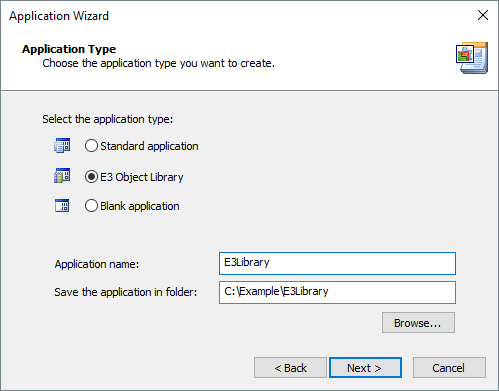An ElipseX is an E3's object Library. In addition to drawings, an ElipseX can contain internal variables that can be exported to an application, and also programming logic (scripts) that is available in all object's copies, diminishing the need to repeat code in several parts of an application.
ElipseXs are encapsulated in a file with a .lib extension. Users can create all ElipseXs to use in a specific project in the same Library file (.lib) or divide them among several files.
To create a new Library in E3, follow these procedures:
1.Select the File - New Project menu and click Next.
2.In the Type of Application option, select the E3 Object Library option.

Creating a user library (ElipseX)
3.Type a name for the Library and click Next.
4.Configure the specifications referring to the Domain.
5.Click Finish.
Within an ElipseX Library, three types of objects can be inserted: XControls, XFolders, and XObjects.
The following items can be inserted in an XControl: drawing primitives (Straight lines, Rectangles, Circles, etc.), vector graphical objects, including objects from the symbol Library (WMF, EMF, etc.), non-vector graphical objects (BMP, JPEG, GIF, etc.), E3's ActiveX controls (E3Alarms, E3Browsers, E3Charts, and E3Playbacks), third-party ActiveX controls, Queries, Alarm Filters, Line Printers, and other XControls.
An XFolder is an object that allows inserting child objects in its instances. Therefore, users can organize or create a ranking of objects in an application. Users can insert in an XFolder instance items such as Data Folders, I/O Tags, Queries, Alarm Filters, and instances of XFolders and XObjects.
An XObject can contain any type of non-graphical objects that are executed in an E3 Server, such as Databases, Alarm Configurations, Formulas, Historics, Storages, Data Servers, I/O Drivers, and Alarms.
NOTE |
The Properties Window of ElipseX objects in object Views can be opened by using the shortcut keys ALT + ENTER or ALT + Double-click. |
Within the same .lib file there may be any number of ElipseX components, either XControls, XFolders, or XObjects. Users can also have several different Libraries within the same Domain.
Notice that for each ElipseX created in a Library two interfaces are internally created, one to declare the object's properties, and another one to declare object's events. These interfaces have their names generated automatically, adding a "D" prefix to that name (the event interface adds the "Events" suffix to this automatic name). If, for example, an object's name is "XObject1", its property's interface is called "DXObject1" and its event's interface is called "DXObject1Events". Any attempt to use these names in other classes in the same Library generates an error code 8002802D, which corresponds to Name already exists in the library.